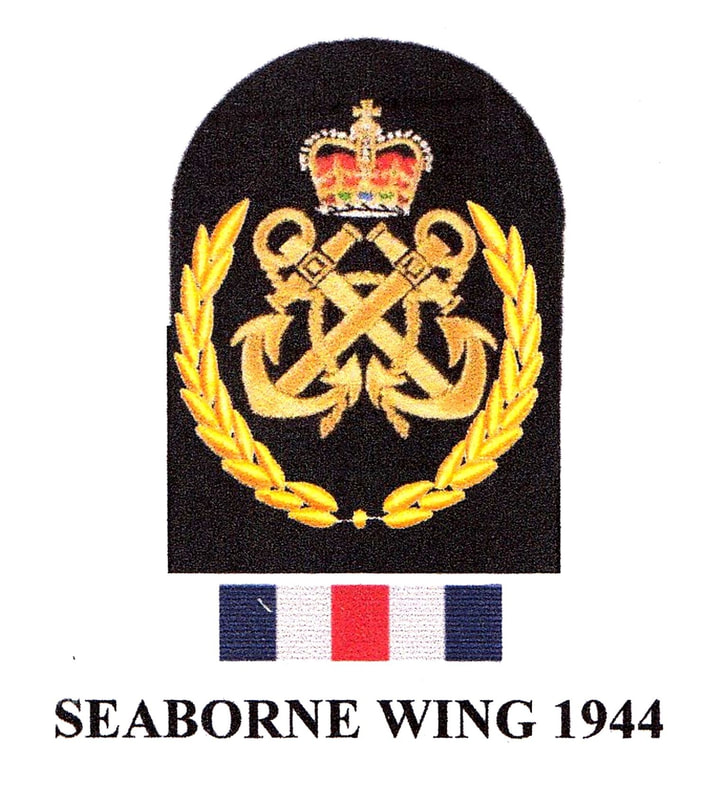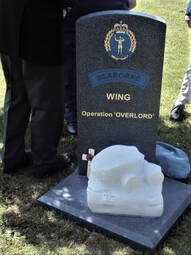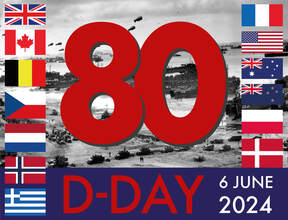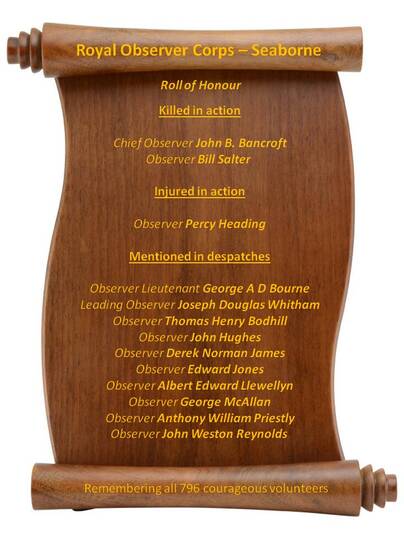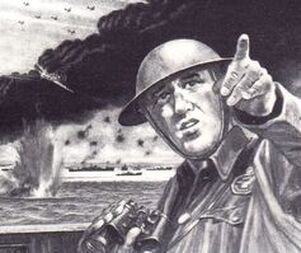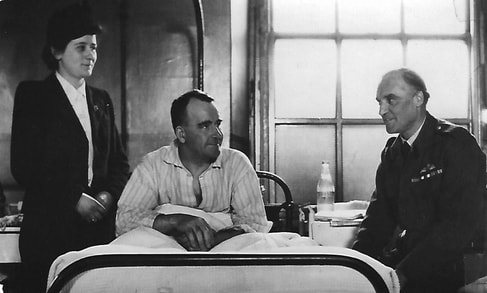Operation Overlord - 80th Anniversary - 6th June 2024
How it all began
|
At a conference held at the Air Ministry on the 5 Aprill 1944 it was agreed that Royal Observer Corps personnel, experienced in aircraft recognition, would be deployed to merchant vessels, wearing Royal Observer Corps uniform with the shoulder flash SEABORNE, and a Royal Navy brassard with the letters RN.
Their ages ranged from17 to 70, the youngest being a schoolboy who, on discharge from the Seaborne Service, returned to the classroom. The Observers were prepared for their role as Air Identifiers at RAF Bournemouth which was based at the Royal Bath Hotel. Following training and testing of their aircraft recognition skills at Bournemouth they were posted to eleven different ports, with the majority being posted to Southampton, London and Cardiff. In total, 796 Observers became enrolled in the Royal Navy with the rank of Petty Officer / Aircraft Identifiers and sailed with the allied invasion forces taking part in Operation Overlord - the codename for the invasion and liberation of occupied Europe. |
The story of Rex Polendine...
Rex Polendine’s war looked set to be spent in Civvie Street when he was invalided out of the RAF. Unable to fight for his country, he did his bit armed with a pair of binoculars picking out the friendly and enemy planes that filled the eastern skies. But as he spent night after night with a permanent crick in his neck protected by a ring of sandbags little did he suspect how different it would be on June 6, 1944.
Rex was a member of the Royal Observer Corps, one of the few full-timers. Most of the plane spotters were professional men who gave up their evenings to keep operation rooms around the country in touch with hostile aircraft lost allied ones and weather reports. In Melton Mowbray it was virtually made up of the Conservative Club” said Rex.
"Most were part timers but there were a nucleus of us ’A’ Observers” But following the loss of allied aircraft in the Italian and Sicilian invasions where huge losses were incurred by ‘friendly fire’ things began to change for Rex and nearly 800 other observers.
Military chiefs wanted to ensure that on the Normandy invasion this would not happen and that was how the ROC’s Seaborne Division was born. The 796 observers were despatched to Wales and the south coast to join the fleet of 6,000 vessels.
''I went to Swansea and joined an American liberty ship ''Melville Jacobi” recalled Rex “The captain didn’t expect to have a couple of ‘limeys’ telling him what to do but he soon realised his crew had never seen a hostile aircraft before. We set off for Omaha beach on June 5 with low priority cargo. Because it was low priority we sat there for six weeks bombarded by the shore batteries and suffering the worst weather the Channel had seen in 40 years. We were there so long other ships used us as a marker. We were never actually hit, but the troop carrier next to us sank after hitting a mine. The Americans wanted to fire at anything that came over the horizon but most of them were ours. It’s a good job the observers were there - Omaha beach proved to be the toughest and the troops did well to take it."
Rex recalled the food was excellent after four years of austerity at home and the Americans were excellent hosts.
“We used to be the butt of jibes when only Fortresses of the Eighth Airforce seemed to go over. They used to ask us if me and my colleague were the only two Britons in the war. Then one day the sky filled with Lancasters, Halifaxes and Sterlings at low level on their way to soften up the German defences. It was a stupendous sight that made us feel proud"
He amused his new American colleagues by drawing them pin ups and cartoons of their circumstances. On his return he painted his impression of the invasion and his living room is adorned with his paintings of favourite aircraft.
“While we were on the seaborne duties we earned £1 a day and held the honorary rank of Petty Officer - that was more than a bomber captain was paid. I think the money was good because the War Ministry didn’t expect to be paying half of us.”
Rex returned to the quiet life of a surveyor, including a spell at RAF Coningsby.
From The British Newspaper Archive - James Mackie
Click on images for full size
Rex was a member of the Royal Observer Corps, one of the few full-timers. Most of the plane spotters were professional men who gave up their evenings to keep operation rooms around the country in touch with hostile aircraft lost allied ones and weather reports. In Melton Mowbray it was virtually made up of the Conservative Club” said Rex.
"Most were part timers but there were a nucleus of us ’A’ Observers” But following the loss of allied aircraft in the Italian and Sicilian invasions where huge losses were incurred by ‘friendly fire’ things began to change for Rex and nearly 800 other observers.
Military chiefs wanted to ensure that on the Normandy invasion this would not happen and that was how the ROC’s Seaborne Division was born. The 796 observers were despatched to Wales and the south coast to join the fleet of 6,000 vessels.
''I went to Swansea and joined an American liberty ship ''Melville Jacobi” recalled Rex “The captain didn’t expect to have a couple of ‘limeys’ telling him what to do but he soon realised his crew had never seen a hostile aircraft before. We set off for Omaha beach on June 5 with low priority cargo. Because it was low priority we sat there for six weeks bombarded by the shore batteries and suffering the worst weather the Channel had seen in 40 years. We were there so long other ships used us as a marker. We were never actually hit, but the troop carrier next to us sank after hitting a mine. The Americans wanted to fire at anything that came over the horizon but most of them were ours. It’s a good job the observers were there - Omaha beach proved to be the toughest and the troops did well to take it."
Rex recalled the food was excellent after four years of austerity at home and the Americans were excellent hosts.
“We used to be the butt of jibes when only Fortresses of the Eighth Airforce seemed to go over. They used to ask us if me and my colleague were the only two Britons in the war. Then one day the sky filled with Lancasters, Halifaxes and Sterlings at low level on their way to soften up the German defences. It was a stupendous sight that made us feel proud"
He amused his new American colleagues by drawing them pin ups and cartoons of their circumstances. On his return he painted his impression of the invasion and his living room is adorned with his paintings of favourite aircraft.
“While we were on the seaborne duties we earned £1 a day and held the honorary rank of Petty Officer - that was more than a bomber captain was paid. I think the money was good because the War Ministry didn’t expect to be paying half of us.”
Rex returned to the quiet life of a surveyor, including a spell at RAF Coningsby.
From The British Newspaper Archive - James Mackie
Click on images for full size
Observers from the North East go to sea...
More than eight hundred members of the Royal Observer Corps voluntarily joined Allied merchant ships during the invasion of Normandy, and their training saved our aircraft from being engaged by ships’ guns.
Twelve men from the North-East answered the call—some youths of eighteen and some veterans of the last war, but none of whom had served at sea before. After a short extensive course in the south they were signed on by the Royal Navy with the rank of petty officer . They watched in pairs, and were mostly on continuous duty for the whole time they were away.
Amazingly few German planes were encountered on the operations. As one of them remarked. “There were so many of our own, there was no room for Jerries.” Leading Observer J. Forbes, of Kintore, formerly a green-keeper, set sail on a British ship the night before “D“- Day '' and was returning from his fifth trip when the Ship was struck and the crew took to lifeboats and were picked up by a destroyer.
Observers R. E. M‘Conachie, of Tarland, and W. Aitkenhead, of Aberdeen, were for for two trips on an American Liberty ship.
On their second trip they encountered six Nazi planes and the ship was raked by cannon fire by one of them, and men standing near Aitkenhead were wounded. They were also attacked by E-boats early in the morning after “D"-Day, and later a bomb hit the ship and it had to be put in for repair. Aitkenhead, who is waiting call -up for the R.AF., was for two and a half years in the 151st Squadron of the AT.C. M'Conachie, who at eighteen is one of the youngest R.O.C. Seaborne observers, helps on his father's farm.
Leading Observer D. Kidd, of Fyvie, for twenty years a poultry farmer, made four journeys on an American ship carrying nurses and medical equipment.
He gave a teeth-watering account of Independence Day on board, when the menu included turkey, plum pudding, ice cream, peaches, and iced cakes!
Observer A. Deans, of Bucksburn, and Chief Observer H. Cooper, of St. Fergus, went across the Channel six times in a British ship, and were sorry to come away‘.
Cooper remarked ! It was a darned good holiday,''
Observer Officer J. L. Brackenridge, of Green Acres, Milltimber, went south as an instructor for the intensive course, and later volunteered for seaborne duty and made two trips. On his first trip he saw several '' doodlebugs " shot into the sea and more on the second trip.
From The British Newspaper Archive - James Mackie
Your browser does not support viewing this document. Click here to download the document.
The reality of being on the front line...
The following photograph was believed to be in the archives of the Imperial War Museum with the inscription on the back:
"P.O.A1 Percy Heading in Naval Hospital after being injured on D-Day, when a German shell hit his ship. He is talking to his daughter and Commander W.G. Moore, OBE, DSC, the Officer Commanding 'Seaborne' "
(There is some doubt over the identity of the Officer on the right of the photograph as W.G. Moore was the Group Commandant of No. 2 Group at the time, but not in charge of Seaborne)
Paul Wakefield
"P.O.A1 Percy Heading in Naval Hospital after being injured on D-Day, when a German shell hit his ship. He is talking to his daughter and Commander W.G. Moore, OBE, DSC, the Officer Commanding 'Seaborne' "
(There is some doubt over the identity of the Officer on the right of the photograph as W.G. Moore was the Group Commandant of No. 2 Group at the time, but not in charge of Seaborne)
Paul Wakefield
The Seaborne Association
The following letters were in the Seaborne Association newsletter of August 1997 including one from Captain T Laurence now Vice Admiral Sir Timothy Laurence, KCVO, CB, CSM, ADC
Heritage Team - Click on images for full size.
Heritage Team - Click on images for full size.
